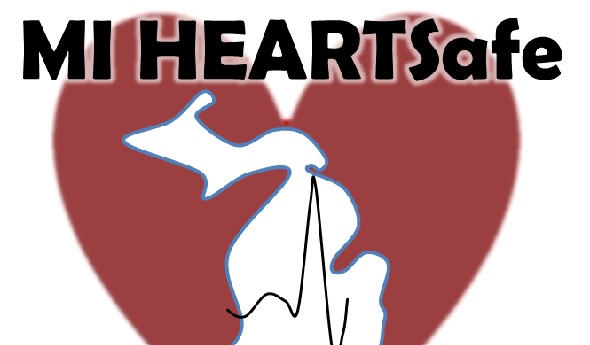
105 Schools Recognized As HEARTSafe
October 19, 2016
The Michigan Departments of Health and Human Services (MDHHS), and Education (MDE); American Heart Association (AHA); Michigan High School Athletic Association (MHSAA); and Michigan Alliance for Prevention of Sudden Cardiac Death of the Young (MAP-SCDY) have awarded 105 schools in Michigan with the MI HEARTSafe School designation which recognizes schools that are prepared to respond to cardiac emergencies.
“Many sudden cardiac deaths that claim the lives of children and young adults could be prevented through screening, detection, and treatment,” said Dr. Eden Wells, chief medical executive of MDHHS. “Appropriate medical response within three to five minutes is crucial for increasing the chance of survival, which is why I’m pleased to see so many of our schools taking vital measures to prepare and address this health issue.”
In order for a school to receive a MI HEARTSafe School designation, it must perform at least one cardiac emergency response drill per year, have a written medical emergency response plan and team, have current CPR/AED certification of at least 10 percent of staff, 100 percent of head varsity coaches, and 50 percent of P.E. staff; have accessible, properly maintained and inspected AEDs with signs identifying their location; and ensure pre-participation sports screening of all student athletes using the current physical and history form endorsed by the Michigan High School Athletic Association.
“We are so proud to support Michigan’s HEARTSafe schools,” said State Superintendent Brian Whiston. “Ensuring schools are prepared for sudden cardiac emergencies through planning, training, and life-saving AEDs is an important part of having safer learning environments for students, staff, and the community.”
Between 2003 and 2012 in Michigan, there were 2,590 young individuals between 1 and 39 years of age who died of sudden cardiac death. Of those, 214 were between 5 and 19 years of age. This is the third year of the MI HEARTSafe Schools program in Michigan. In the first two years of the initiative, 162 schools were previously designated as MI HEARTSafe Schools and prepared to help reduce the number of sudden cardiac deaths in our youth.
Public Act 12 of 2014 requires all schools (grades kindergarten to 12) to have a cardiac emergency response plan in place. This MI HEARTSafe School designation recognizes the 267 school buildings that have taken steps above and beyond to prepare to respond in the event of a cardiac emergency, and is awarded for a period of three years. Click for the list of designated schools.
Schools that meet all of the requirements will be able to apply for the MI HEARTSafe School designation each year. Click for information about the MI HEARTSafe Schools program.

Baseball's Record-Setting Spectatorship Headlines MHSAA's 2024-25 Attendance Report
By
Geoff Kimmerly
MHSAA.com senior editor
December 12, 2025
An overall attendance record in baseball and several more all-time bests for specific rounds of other sports’ postseason tournaments kept attendance at Michigan High School Athletic Association events near 1.4 million spectators for the third-straight school year in 2024-25.
Total, MHSAA Tournament events drew 1,397,574 spectators at competitions for which admission is charged – which counts all MHSAA-sponsored sports except golf, skiing and tennis, as single tickets are not sold for those postseason events. The total of just under 1.4 million spectators is a decrease of 3.6 percent from 2023-24, but still the third-highest overall attendance over the last eight school years.
Attendance at girls events for 2024-25 was 453,320 fans, a 3.9-percent decrease from the 2023-24 record-setting total but the second-highest over the last eight years.
The boys attendance of 944,254 was 3.4 percent fewer than the previous year. However, baseball set an overall tournament record with 65,150 spectators, with records as well of 38,086 at the District level and 7,517 attending Quarterfinals. Every round of the baseball postseason saw an increase from the previous year.
Overall attendance totals for the ice hockey, team wrestling, gymnastics, boys soccer and girls swimming & diving postseason tournaments also were up from 2023-24. Ice hockey set records at its Semifinals (7,758 spectators) and Finals (7,857), boys soccer at the District level (18,219) and team wrestling also at its Finals (11,604).
Football remains the most-attended MHSAA Tournament sport and drew 361,139 spectators for its playoff series – a decrease of just above a half-percent from the previous year but with the highest Finals turnout (44,535) since 2019-20. Boys basketball attendance remained second across all seasons at 251,668 spectators, followed by girls basketball at 145,313 and girls volleyball at 110,927.
Track & field (41,418 spectators) and softball (47,763) posted their second-highest attendances on record after setting records during the 2023-24 school year.
The MHSAA is a private, not-for-profit corporation of voluntary membership by more than 1,500 public and private senior high schools and junior high/middle schools which exists to develop common rules for athletic eligibility and competition. No government funds or tax dollars support the MHSAA, which was the first such association nationally to not accept membership dues or tournament entry fees from schools. Member schools which enforce these rules are permitted to participate in MHSAA tournaments, which attract more than 1.4 million spectators each year.

